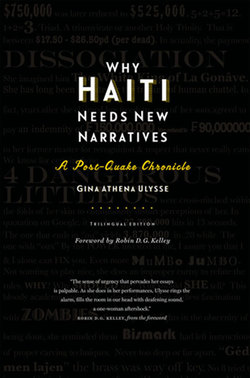Читать книгу Why Haiti Needs New Narratives - Gina Athena Ulysse - Страница 13
На сайте Литреса книга снята с продажи.
Оглавление1
Avatar, Voodoo, and White Spiritual Redemption
January 11, 2010 / Huffington Post @ 1:13 p.m.
Avatar is not just another white-man-save-the-day movie. As a black woman and a cultural anthropologist born in Haiti, I had doubts about the depiction of race in the film. Before seeing Avatar, I worked on resisting the urge to categorize this film as yet another Dances with Wolves, The Last Samurai, or Pocahontas redux, as some critics have dubbed it. White-man-gone-native is the favored trope that mainstream Hollywood writers use when exploring (neo)colonial encounters between indigenous people and whites.
A white environmental anthropologist friend, whose judgment of representations of race I trust, loved it. So I decided to see the film, even though Haitian Listservs were buzzing about how Dr. Grace Augustine (Sigourney Weaver), in typical Hollywood fashion, demeaned one of the religions I grew up with. “We’re not talking about pagan voodoo but something that is real biologically: a global network of neurons.” An unapologetic lover of Vodou, I went to see for myself.
After seeing Avatar, I urged my younger sister to go take a look. We were both curious for different reasons. In our debriefing, we discussed the different aspects of the film that made us squirm. Blue monkey-like people played by dark actors. The noble savage narrative. The angry blue men competing with the good white guy who wins the blue girl. There were parts that we did like. It was absolutely beautiful. We were both in awe of the images of nature—a lush and glowing ecological world. The skills of animation. Then we went back to the uncomfortable moments. We spoke of the successful transferring scene when Moat (played by C. C. H. Pounder) led the ceremony that freed Jake Sully from his physically challenged white body. As high priestess, Moat called on the Na’Vi’s god Eywa for assistance. Seated, they encircled the tree with braced arms and moved in total unison.
Their repetitive chanting soon became drumming. “Sacred dance, sacred dance, sacred dance,” my sister said she kept murmuring to herself. She actually teaches a sacred dance class, and it was too familiar. The movements, setting, altar, offerings. Communion with nature. All beings are interconnected. The Na’Vi do not distinguish between themselves and their environment. We came back to the tree.
In Haitian Vodou ecology, trees have always been sacred. They are significant in rituals, as they are inhabited by spirits. Rapid deforestation of the island has impacted worship. In overpopulated urban settings, practitioners are living in what one scholar recently referred to as “post-tree Vodou.”1
It should be noted that deforestation of the island has some of its origins in the U.S. occupation of 1915–34. Then my sister pointed out that during the entire film, there was no mention of the Sky People’s god. It’s all New Age spirituality. New Age spirituality, with its purported openness, may incorporate some African-based religious practices, especially from Latin America, but (Haitian) Vodou remains stigmatized therein, especially in interfaith circles. Although a growing number of initiates are whites, few multidenominational churches dare to acknowledge it. Cultural specificities aside, Vodou shares core features—spirits, nature, ceremonies, and offerings—with other mystical religions. Avatar is a reminder of the hierarchy within alternative religions.
Surprisingly, I sat through Avatar with disciplined patience. I am so used to epic films about indigenous people always having white heroes, whether they be historical, contemporary, or science fiction fantasies. The Hollywood blockbuster machine with its penchant for good-versus-evil won’t risk financing tropes with alternative narratives. Is slavery not the worst of evils and Napoleon Bonaparte the ultimate villain? Yet a film about the Haitian Revolution—the only successful slave revolution that ousted European colonizers—still can’t seem to get off the ground. And the depiction of voodoo, Walt Disney recently reminded us, is still evil: see The Princess and the Frog.
To be sure, while Avatar doesn’t break free of Hollywood tropes, it does allow white characters to break out of dominant worldviews. The film had a range of Sky People who fought among themselves. In fact, the triumphant ones were all outcasts. A paraplegic man. A minority woman. An effeminate nerd. A masculinist white female scientist. A minority science man. There was also corporate greed. Military might. Skeptics and believers. There was a critique of science with irony. The cerebral Dr. Grace realized too late that the Na’Vi’s mystical voodoo is as valid and real as the science. She did not make the crossing, while the more visceral Jake, who went rogue, did.
The clash of cultures and races is an easy way for moviemakers to explore personal transformation. In too many films, dark bodies have systematically been the catalyst for white salvation. Avatar forces us to confront these contradictions as we wait for the epic film that has yet to be made—one that tells the natives-meets-white-men story from their perspective.
Half of life is figuring out which contradictions you’re willing to live with.
—Savyasaachi
